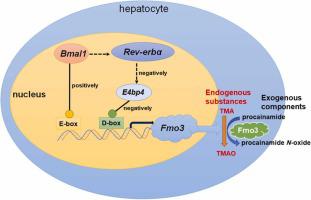当前位置:
X-MOL 学术
›
Int. J. Biochem. Cell Biol.
›
论文详情
Our official English website, www.x-mol.net, welcomes your feedback! (Note: you will need to create a separate account there.)
Deciphering the diurnal rhythm regulating mechanism of flavin-containing monooxygenase 3 in mouse liver
The International Journal of Biochemistry & Cell Biology ( IF 4 ) Pub Date : 2024-02-04 , DOI: 10.1016/j.biocel.2024.106538 Meixia Huang , Shuyi Duan , Qiwen Zhang , Lianxia Guo , Zifei Qin , Jing Yang
The International Journal of Biochemistry & Cell Biology ( IF 4 ) Pub Date : 2024-02-04 , DOI: 10.1016/j.biocel.2024.106538 Meixia Huang , Shuyi Duan , Qiwen Zhang , Lianxia Guo , Zifei Qin , Jing Yang

|
Circadian genes play an important role in the field of drug metabolism. Flavin-containing monooxygenase 3 is a well-known phase I enzyme which participates in metabolism of many exogenous and endogenous substances, especially production of trimethylamine -oxide. Here, we aimed to decipher diurnal rhythms of flavin-containing monooxygenase 3 expression and activity, and explore the regulation mechanism by clock genes. Our results showed that its mRNA and protein exhibited robust diurnal rhythms in mouse liver and cell lines. Consistently, significant alterations were observed for microsomal -oxidation rates of procainamide, which kept in line with its protein expression at different time in wild-type and reverse erythroblastosis virus α knockout mice. Further, flavin-containing monooxygenase 3 was negatively regulated by E4 promoter-binding protein 4 in AML12 and Hepa1–6 cells, while it was positively influenced by reverse erythroblastosis virus α and brain and muscle ARNT-like protein-1. Moreover, luciferase reporter assays and electrophoretic mobility shift assays showed E4 promoter-binding protein 4 inhibited the transcription of flavin-containing monooxygenase 3 by binding to a D-box1 element (−1606/−1594 bp), while brain and muscle ARNT-like protein-1 positively activated the transcription direct binding to three E-boxes (−863/−858 bp, −507/−498 bp, and −115/−104 bp) in this enzyme promoter. Taken together, this study would be helpful to reveal the mechanism of clock-controlled drug metabolism and facilitate the practice of chrono-therapeutics.
中文翻译:

破译小鼠肝脏中含黄素单加氧酶3的昼夜节律调节机制
昼夜节律基因在药物代谢领域发挥着重要作用。黄素单加氧酶3是一种众所周知的I相酶,参与许多外源性和内源性物质的代谢,特别是氧化三甲胺的产生。在这里,我们的目的是破译含黄素单加氧酶3表达和活性的昼夜节律,并探索时钟基因的调控机制。我们的结果表明,其 mRNA 和蛋白质在小鼠肝脏和细胞系中表现出强大的昼夜节律。一致地,观察到普鲁卡因酰胺微粒体氧化率的显着变化,这与其在野生型和逆成红细胞增多症病毒α敲除小鼠中不同时间的蛋白表达保持一致。此外,在 AML12 和 Hepa1-6 细胞中,含黄素单加氧酶 3 受到 E4 启动子结合蛋白 4 的负向调节,而受到逆成红细胞增多病毒 α 和脑和肌肉 ARNT 样蛋白 1 的正向影响。此外,荧光素酶报告基因测定和电泳迁移率变动测定表明,E4启动子结合蛋白4通过与D-box1元件(−1606/−1594 bp)结合来抑制含黄素单加氧酶3的转录,而大脑和肌肉ARNT样Protein-1 正向激活与该酶启动子中的三个 E 盒(−863/−858 bp、−507/−498 bp 和 −115/−104 bp)直接结合的转录。总而言之,这项研究将有助于揭示时钟控制药物代谢的机制,并促进时间治疗的实践。
更新日期:2024-02-04
中文翻译:

破译小鼠肝脏中含黄素单加氧酶3的昼夜节律调节机制
昼夜节律基因在药物代谢领域发挥着重要作用。黄素单加氧酶3是一种众所周知的I相酶,参与许多外源性和内源性物质的代谢,特别是氧化三甲胺的产生。在这里,我们的目的是破译含黄素单加氧酶3表达和活性的昼夜节律,并探索时钟基因的调控机制。我们的结果表明,其 mRNA 和蛋白质在小鼠肝脏和细胞系中表现出强大的昼夜节律。一致地,观察到普鲁卡因酰胺微粒体氧化率的显着变化,这与其在野生型和逆成红细胞增多症病毒α敲除小鼠中不同时间的蛋白表达保持一致。此外,在 AML12 和 Hepa1-6 细胞中,含黄素单加氧酶 3 受到 E4 启动子结合蛋白 4 的负向调节,而受到逆成红细胞增多病毒 α 和脑和肌肉 ARNT 样蛋白 1 的正向影响。此外,荧光素酶报告基因测定和电泳迁移率变动测定表明,E4启动子结合蛋白4通过与D-box1元件(−1606/−1594 bp)结合来抑制含黄素单加氧酶3的转录,而大脑和肌肉ARNT样Protein-1 正向激活与该酶启动子中的三个 E 盒(−863/−858 bp、−507/−498 bp 和 −115/−104 bp)直接结合的转录。总而言之,这项研究将有助于揭示时钟控制药物代谢的机制,并促进时间治疗的实践。



























 京公网安备 11010802027423号
京公网安备 11010802027423号